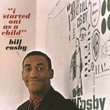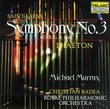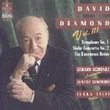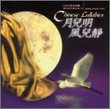| All Artists: Steve Reich, Grand Valley State University New Music Title: Music for 18 Musicians Members Wishing: 3 Total Copies: 0 Label: Innova Original Release Date: 1/1/2007 Re-Release Date: 10/16/2007 Album Type: Hybrid SACD - DSD Genres: Dance & Electronic, New Age, Pop, Rock, Classical Styles: Techno, Vocal Pop, Historical Periods, Modern, 20th, & 21st Century Number of Discs: 1 SwapaCD Credits: 1 UPC: 726708667825 |
Search - Steve Reich, Grand Valley State University New Music :: Music for 18 Musicians
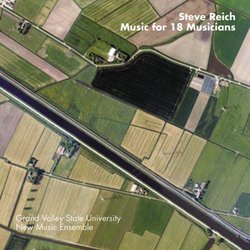 | Steve Reich, Grand Valley State University New Music Music for 18 Musicians Genres: Dance & Electronic, New Age, Pop, Rock, Classical
|
Larger Image |
CD DetailsSimilarly Requested CDs |
CD ReviewsRepetition is the point S. McPherson | St. Paul, MN United States | 02/12/2008 (5 out of 5 stars) "I can't pretend to any particularly deep knowledge of experimental music, but I've dabbled as a student and listener. So when a titan of modern experimental music like Steve Reich acknowledges a recording of one of his own pieces as "a really moving recording of the piece" and "a gorgeous and stunningly accurate CD of Music for 18 Musicians, from the heartland to the heart," I know enough to pay attention. Reich has consistently managed to invest his abstract and experimental compositions with real human heart and a populist spirit, as evidenced by his best known work, Different Trains, which was realized as a recording in collaboration with The Kronos Quartet. He's also dead-on about Minneapolis label Innova's release of GVSU's New Music Ensemble's reading of Music for 18 Musicians; it's mesmerizing, beautiful, and delicately realized, despite the sheer volume of notes. Reich has always focused, more or less, on the effects of repetition and subtle change on music. As such, his work tends to be minimally composed but maximally realized, and in Music for 18 Musicians, he based the piece around a cycle of eleven chords. The cycle introduces and closes the piece in a section called "Pulses," and in between, eleven sections explore each chord. I know: it sounds dry and terribly clinical, but it's not. The music is a cascade of notes, a kind of mechanized modulation of John Coltrane's sheets of sound approach. Instead of chaotic and improvised bursts of melody, the music swells and recedes like the ocean, the ensemble of strings, clarinets, pianos, marimbas, and xylophones softly urging the music into being. The dynamics couldn't be simpler, really: the percussive instruments lay down a steady rhythm while the cellos, violins, and clarinets breathe melodies against it. Here and there, the xylophones or marimbas step forward to outline a melody, or the strings will buildup into a rhythm. Subtle elements make a big difference here; when a shaker suddenly enters or a human voice is heard distantly, it resonates like a ripple in water. Shards of melody arise and dissipate in a way that should be familiar to fans of electronic artists like Aphex Twin or Autechre, and even fans of metal bands like Sunno))) or Boris. This is because Reich's influence in popular music has emerged largely as a concern with texture. Music for 18 Musicians can be read as a meditation on sound and its properties, and it's beautifully balanced between rhythmic and melodic focus. It's simultaneously meticulous and organic. For the casual listener, this is Reich's greatest bequest, and GVSU's New Music Ensemble has clearly stepped to the front of the line with their sensitive and lucid recording, which makes use of Surround Sound and SACD technology for those equipped with such high-end options. It's a remarkably flexible piece and recording, whether you choose to delve with headphones or listen in the car. In fact, the car may well be the ideal environment for Music for 18 Musicians. The music rises and falls gently like the landscape on a cross country drive, echoing the way guide rails seem to emerge from the ground and run parallel for a while before falling away again. When you were a kid, you could stare out the window for hours on these drives, because in a way, you never moved, even as the world arose and collapsed beside you. Now we look forward, making important decisions and guiding our lives, but Reich's piece is a reminder to sometimes look off to the side as we speed through the world." A wonderful birthday present DJ Rix | NJ USA | 02/23/2008 (5 out of 5 stars) "I can't imagine a lovelier gift for Steve Reich's 70th birthday than when this group from an obscure Allendale, Michigan school showed up at the New York City Bang on a Can Marathon in June 2007 & gave a warmly idiomatic, accomplished sunrise performance of "Music for 18 Musicians." True, the "conductor" & several of the students had consulted with members of the Steve Reich Ensemble & met the composer. But Reich probably never expected they'd do this well. Yet, for all the sophistication of Reich's music & his international reputation, he must have dreamed of it from time to time, hearing a reassuring echo from the provinces, that his music had made such a successful journey out & back. These aren't virtuoso conservatory kids; they're fine musicians from a large academic music department who likely had to give up some other projects & activities to make the committment. The students are joined by a few faculty & outsiders, but it's their gig. They had to live inside the score for a year to bring it to this level. You don't have to be a virtuoso to perform "Music for 18 Musicians." You do have to be part of a virtuoso ensemble perfomance, & have great stamina. Back in 1974, Reich brought a few of his musicians out to Ramapo College of New Jersey for a workshop. I was a student. He was working on music like this, perhaps not this particular piece. His "scores" were fragments, phrases, no single phrase was really difficult, & you learned the phrases one after the other. To that point it resembled gamelan. Except it wasn't gamelan. The difficulty was jumping from one phrase to next, while listening to others, & feeling the pulse of the music. Once you started the music, you had to keep going. Our traditional backgrounds had not prepared us, & Reich himself asked which of us had played in rock or jazz groups because he felt that experience was more valuable for what the music required. Still, it wasn't something you just stepped up, read through, & played. Had you asked me then what it would take for a bunch of state college student musicians to master "Music for 18 Musicians," I probably would have replied that it would take months of living with it. So that's what they did at 30 years later at Grand Valley State University. If you have Reich's original recording on ECM or the 1998 version on Nonesuch & want another take, this one is very worthy, & different. The best of the rest, in my opinion, with natural, live sound." Acceptable Performance chapmaning | 09/04/2008 (4 out of 5 stars) "I have studied this piece thoroughly over many years. This performance really deserves a B-, but I rounded up to 4 stars. The good: the overall aim of the piece is achieved, but just barely. The bad: for minimalism of this sort, everything has to be perfect and seamless. Sections need to overlap, and all parts need to be absolutely in tune and interlocking. That said, there are numerous issues with one set of instruments playing too fast and others too slow so that the pulses don't match up. There are several intonation problems, especially in the clarinets and voices. The transitions to new chords and new sections of the piece are almost always clunky. In light of modern recording techniques, a recording of this sort ought to be flawless. There are infinite possibilities for new takes and re-recording of parts. Also, as for the recording, the mix itself is a bit shoddy, and is only B-quality.
Worth owning if you are a serious student of this piece, or an ensemble director looking to emulate a good student performance while avoiding predictable mistakes." |

 Track Listings (14) - Disc #1
Track Listings (14) - Disc #1